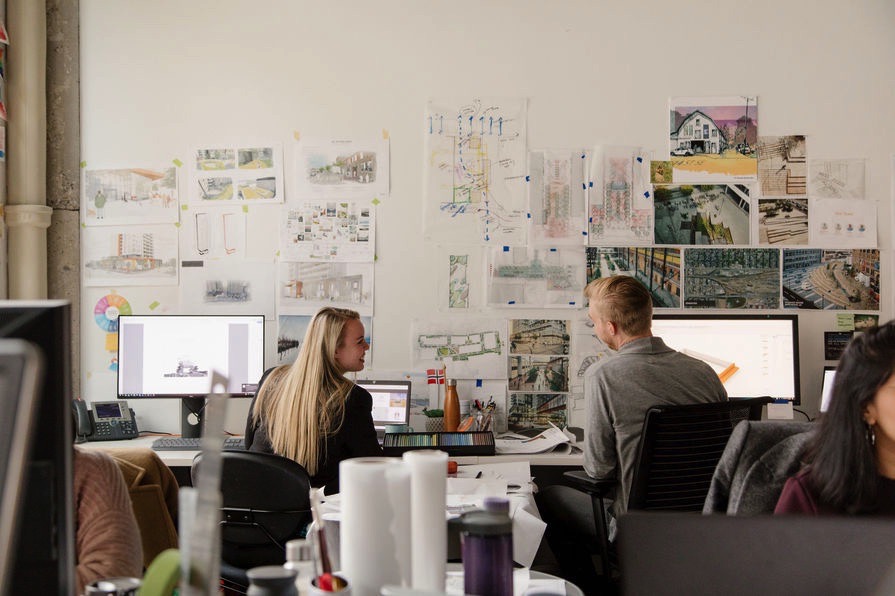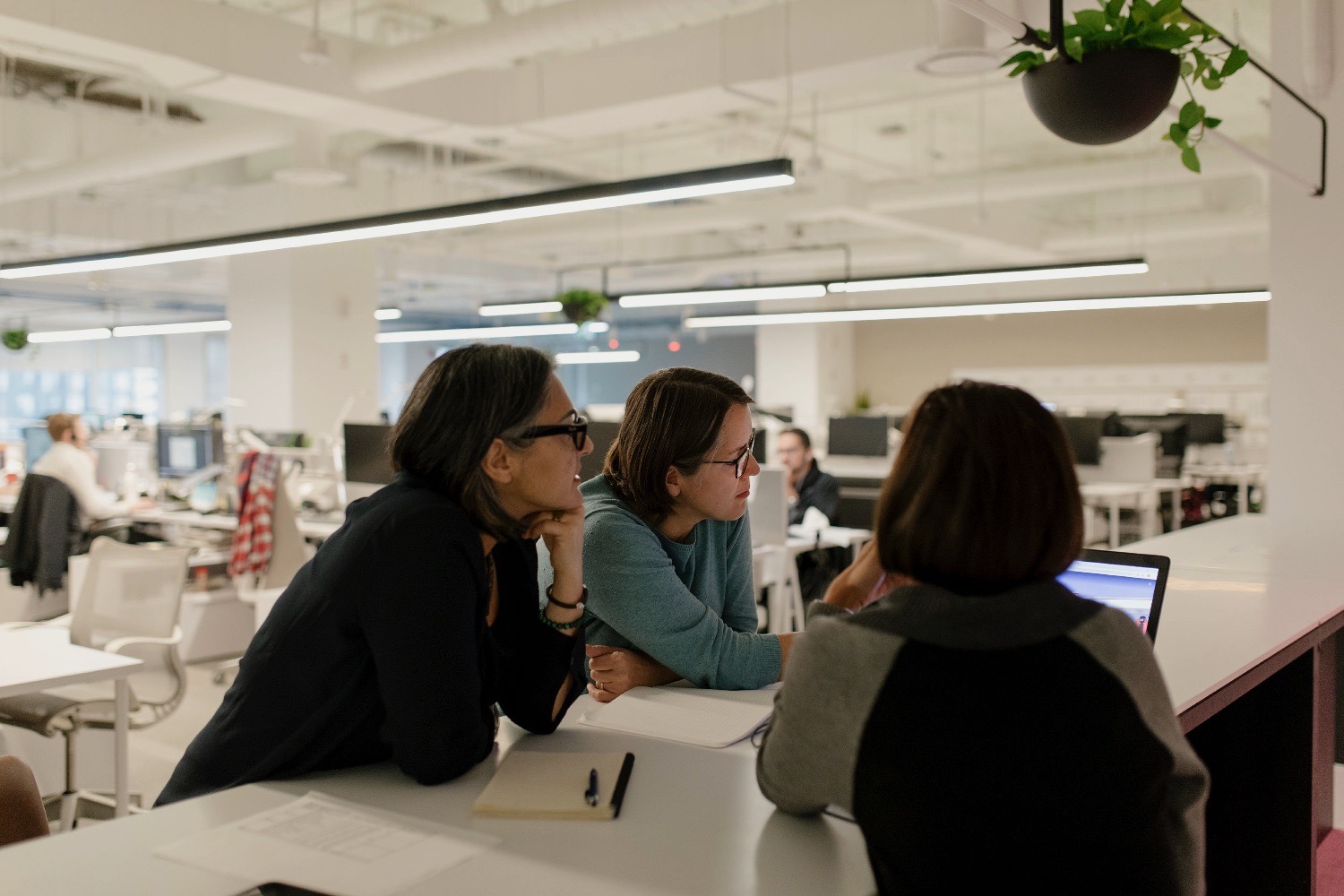A New Apprenticeship
A key component of an architect’s education is apprenticeship. How can we nurture informal learning and mentorship in an online working environment?
The delicate dance that occurs among collaborators when tackling a design problem is a balance of ideas, communication and ego. Innovation can be sparked with a seemingly innocuous comment; heated debates can occur as different paths emerge. It can be exciting. It can be difficult. Emotions that run high must be acknowledged, then relinquished to refocus on the task at hand.
I learned this lesson—and many others—as a junior intern while working on a very large, complex project. Its success required close collaboration between several strong leaders. Sitting within earshot from two of the project’s architectural principals and working elbow-to-elbow with talented colleagues, the open studio working environment was a crucible of learning. My actual tasks were simple, but by being surrounded by more experienced staff while doing them, I learned lessons of leadership, compassion and collaboration. It was in large part an unconscious process—by overhearing conversations, I understood the context of my-day-to-day work in a meaningful way.

My experience is not unique. In the book Situated Learning: Legitimate Peripheral Participation (1991), social anthropologist Jean Lave and educational theorist Etienne Wenger describe learning as a social process, rather than a matter of individual cognitive development. Through apprenticeship, team members become part of a “community of practice” where “old timers” model behaviours and norms for learners. Learners for their part, engage through “legitimate peripheral activities” – simple, stepping-stone tasks. For example, an intern architect might be tasked with cutting out model pieces. In doing this activity within a community of practice, they will also be exposed to the work of more experienced practitioners; overhearing discussions, and observing the work on their colleagues’ screens and desks. The context, interaction and social nature of these activities deepen the learners’ understanding of their practice and profession.
Like many other Canadian architects, I am approaching the one-year anniversary of working from home due to Covid-19. One full year of being away from my beloved, energy-filled open studio workplace in Toronto. And one full year of hearing predictions, projections, and postulations that how we work may never be the same.
Most of these discussions have highlighted how being physically together on a daily basis may not be as important as we once thought. Remote work and dispersed teams may create opportunities to increase flexibility and leverage faraway talent. There may be cost savings in reduced rent, and fewer commutes could help curtail greenhouse gas emissions.
But what about the impact on professional development? How will we replicate the invaluable informal learning experiences that come from being together, when being apart is increasingly the norm?
The answer may lie in one of Lave and Wenger’s central ideas: the community of practice. This concept describes an environment that allows for different perspectives, creates a sense of social fabric, and supports different levels of participation. We can leverage Lave and Wenger’s research by identifying strategies that support these characteristics in the context of working remotely.

Cohort Learning
Learning cohorts are widely used by educational and business organizations and can support learning for architects as well. A well-known case study from the 1980s shows the power of a learning cohort. In this study, an anthropologist followed Xerox copier repair technicians throughout their working day. While they were considered independent workers, in fact, it turned out that the technicians frequently met informally with each other. The anthropologist identified these informal chats as valuable learning moments—the repair technicians were sharing knowledge about how to repair machines better. As a result of this observation, Xerox reorganized the tech reps from being independent workers to being part of social learning units. [1]
In How to Help Your Employees Learn from Each Other,[2] Kelly Palmer and David Blake describe how peer-to-peer learning leverages our natural inclination to ask a colleague or friend for help when learning a new skill. To develop a successful learning cohort, Palmer and Blake suggest that the group uses an outside facilitator and honors confidentiality to create a safe space for risk-taking and vulnerability.
I am lucky to be a part of a learning cohort with members from across the country. Our learning cohort flowed out of a 2019 leadership training program sponsored by the design practice I work for, DIALOG. Our in-person training included peer coaching and was externally facilitated to develop a secure, trusting environment. After completing our training, we decided to set up regular online meetings as we worked on independent projects. We shared and received feedback on our ideas, tested out some work scenarios, and commiserated on our setbacks. It was a place we could take risks. Despite not seeing each other in person during the pandemic, our comradery and friendship flourished, and we continued to learn from each other over a year filled with uncertainty.

Storytelling
Design organizations regularly leverage the power of stories for marketing and business development. Most architects are very good at telling the story of how a project came to be, and describing how the physical building embodies a story. We love to share stories of how a seemingly insurmountable design problem resulted in a beautiful moment in a building; how a site inspired an entire concept; how a client’s life was improved thanks to our work. We are less familiar with the role of the story as a learning tool.
As Harvard University researchers Deborah Sole and Daniel Grey Wilson describe: “Stories can be a very powerful way to represent and convey complex multidimensional ideas. Well-designed, well-told stories can convey both information and emotion, both the explicit and the tacit, both the core and the context.”[3]
Project post-mortems or lessons-learned sessions are a good starting point for learning through stories. These sessions can be further elevated by having project leaders model courage when being honest and open in telling the story of a mistake that was made and how it was addressed. There are also valuable personal and professional lessons learned from projects, which are not typically covered in these sessions. For example, a lessons-learned session could include insights on how a client relationship was nurtured, or how a team member dealt with a stressful incident. Such stories provide additional context on the practice of architecture, going beyond the logistics of designing and creating a building.
From an organizational standpoint, architecture and design firms can develop and share stories that embody the vision or guiding principles of an organization. Through stories, a firm can differentiate itself from other organizations. Whether staff are working remotely or in-person, such stories also help them develop an understanding of the underlying values driving their work. A foundational story can be an important aspect of the onboarding process. Further, “oldtimers” can be given opportunities to share stories about their careers, how they came to be in their current role, and what they learned from their own mentors and experiences.
Sharing stories can also provide a sense of connection when people cannot gather together physically. A growing body of research indicates that humans are wired to connect to each other through storytelling. Princeton University neuroscientist Uri Hasson found that when his subjects listened to an engaging story, their brainwaves began to synchronize with each other, as well as with those of the storyteller.[4]
Akin to drawing or project management, storytelling is a skill that may need to be actively developed. Lave and Wenger describe how members of Alcoholics Anonymous develop this skill over time and through practice. There are opportunities to hone storytelling skills through giving presentations or Ted Talks, and through formal courses and training with organizations such as Toastmasters and Second City.

Organizational Culture
There are dozens of ways to characterize organizational culture. My preferred definitions are from leadership consultants GothamCulture and Harvard Business Review’s Michael D. Watkins. GothamCulture describes organizational culture as “the underlying beliefs, assumptions, values and ways of interacting that contribute to the unique social and psychological environment of an organization.”[5] This leads to, in Watkins’ words, a “consistent, observable pattern of behavior in organizations.”[6] The studio environment of many architecture firms creates vibrant opportunities to observe an organization’s culture in action, with “old timers” and leaders regularly modeling behavior while newcomers observe them.
Though seemingly unrelated to a discussion about how architects learn, the story of the American POWS held in Hỏa Lò Prison during the Vietnam War provides surprisingly relevant insights into organizational culture and some of the challenges associated with remote work. Lessons from the Hanoi Hilton, by Peter Fretwell and Taylor Baldwin, describes the story of hundreds of American POWs held in North Vietnam from 1964 through to 1973. Following the prisoners’ release, physicians and researchers were surprised to find that, despite years of brutal torture and confinement, 61% of the men self-reported “favourable significant mental changes” compared to 32% of a control group. Further, the rates of PTSD among this group was surprisingly low. Long-term tracking found that a high proportion of these men went on to become some of America’s most successful citizens in their chosen fields, including military personnel, physicians and politicians.[7] What made the difference for the Hanoi Hilton POWs? Fretwell and Baldwin conclude that it was a virtual leader and an organizational culture sustained by a social network.
During the earlier years of confinement, the prisoners at the Hanoi Hilton were isolated from each other in individual cells. They were threatened with violence if caught speaking to each other. In this extreme environment, Commander James Stockdale established the mission “Return with Honor,” along with key principles for behavior and guidance for the POWs. The mission’s precepts were transmitted by a secret tap code. The prisoners quietly tapped messages between their cells at night, amplifying the sound using a drinking cup held to their ears. Because the men could only communicate directly with those located beside them, every POW knew that he was personally responsible for sharing, supporting and maintaining the mission and culture. If one person did not participate, the chain of communication was broken.
Though our current experience is not comparable to the hardships endured by the Hanoi POWs, the story highlights that an organizational culture can be created and sustained even in the face of isolation – if everyone clearly understands that maintaining an organization’s culture is part of their daily duties. We can apply this lesson in the context of architectural practice by identifying behaviours and actions important to maintaining the organizational culture of a firm, and entrenching them as a key part of staff roles. In an all- or partly-virtual environment, the alignment of values between individual staff members and an organization will become increasingly important.
Though individual practitioners and organizations will differ in their assessments on what is to come for our industry, this past year of designing and building through a pandemic has shown that we can dramatically—and quickly—change the way we work. Some firms may enthusiastically embrace remote work and never go back. Some may hope that the end of Covid-19 will mean a quick snap back to the status quo. Most will likely land somewhere in the middle: accepting that significant change is afoot with remote work, dispersed teams, and a new role for our physical studios and office spaces.
As we reconsider our physical studios or offices and test out new modes of project delivery, we must also give thought to how apprenticeship learning will have to evolve. The informal, ongoing education of architects will have to shift from being a byproduct of working in a studio, to an activity that is planned, nurtured and supported. Luckily, there are researchers who study this phenomenon in detail. Their explorations and stories can help us navigate our current crisis—as well as a future brimming with opportunity.
Toronto-based architect Tracy Lee is an Associate at DIALOG.
[1]https://www.researchgate.net/publication/242189756_Storytelling_in_Organizations_The_power_and_traps_of_using_stories_to_share_knowledge_in_organizations
[2] https://hbr.org/2018/11/how-to-help-your-employees-learn-from-each-other
[3]https://www.researchgate.net/publication/242189756_Storytelling_in_Organizations_The_power_and_traps_of_using_stories_to_share_knowledge_in_organizations
[4] https://www.cgsinc.com/blog/storytelling-and-its-impact-on-learning
[5] https://gothamculture.com/what-is-organizational-culture-definition
